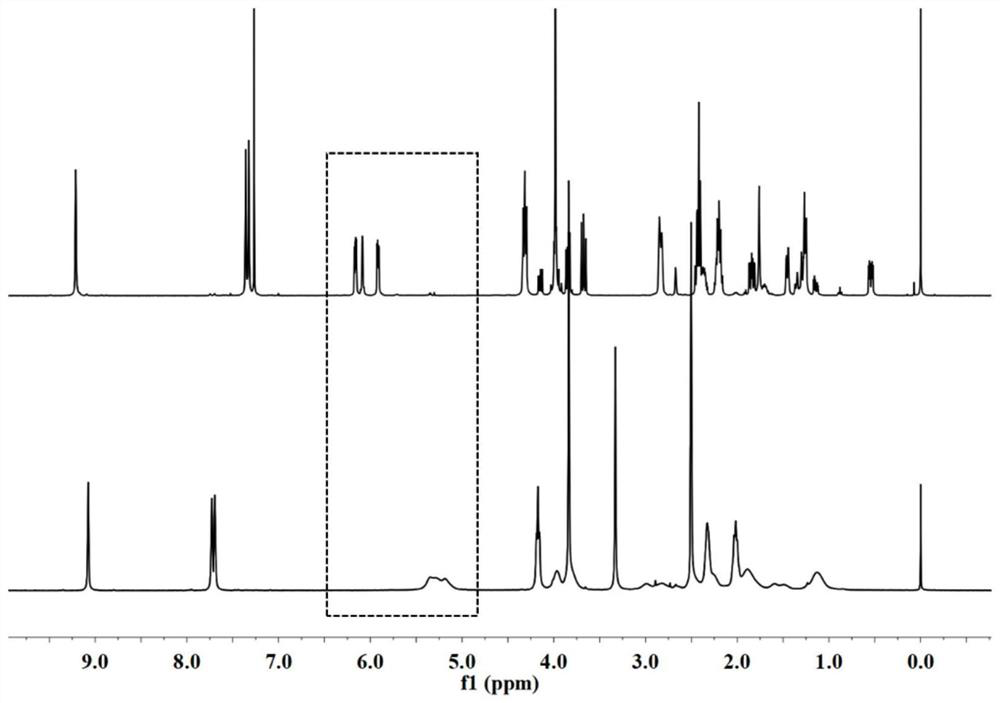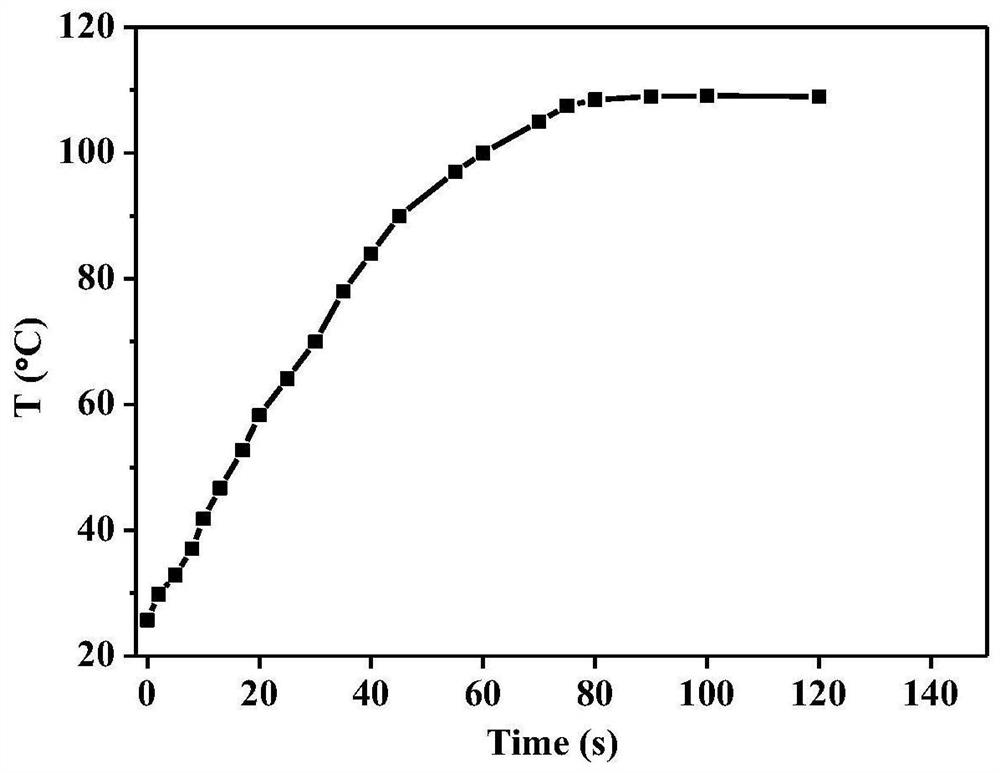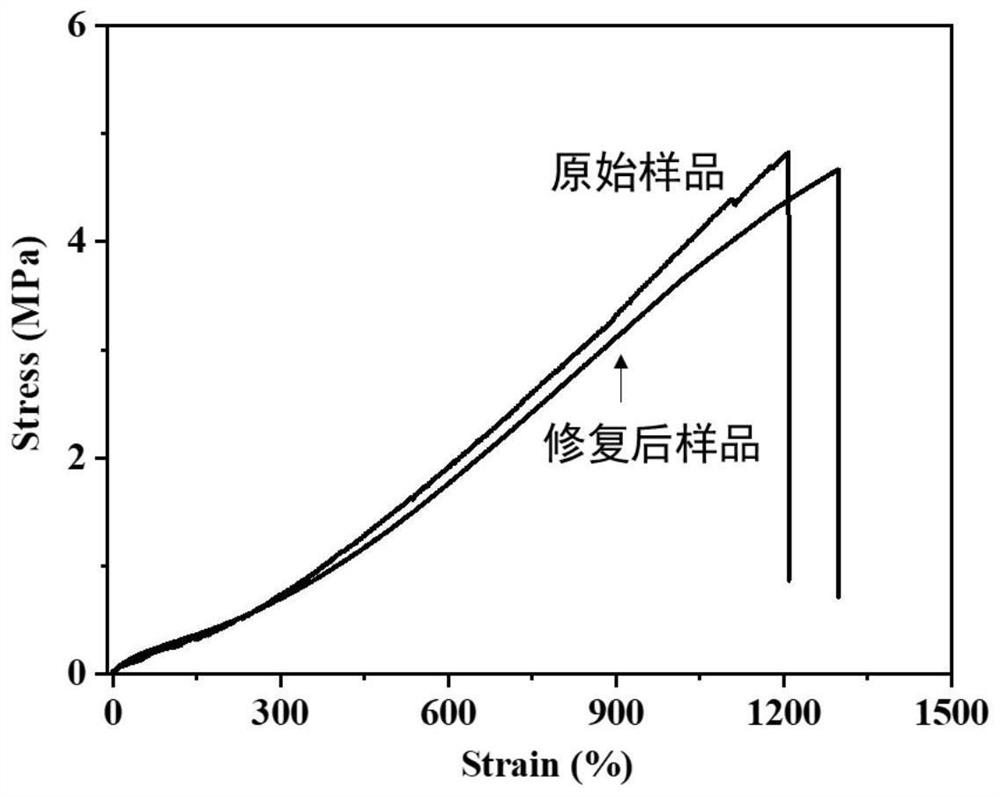Ionic cycloolefin polymer, photo-self-repairing material based on ionic cycloolefin polymer, and preparation method and application of photo-self-repairing material
A cyclic olefin polymer and self-healing material technology, applied in the field of self-healing materials, can solve the problems of complex preparation process and promotion limitations, and achieve the effects of good substrate universality, obvious photothermal effect, and mild conditions.
- Summary
- Abstract
- Description
- Claims
- Application Information
AI Technical Summary
Problems solved by technology
Method used
Image
Examples
Embodiment 1
[0049] The general structural formula of ionic cycloolefin polymer is:
[0050]
[0051] Wherein, side chain length m=3, n=0, degree of polymerization y=100, X=perfluorobutanesulfonic acid anion (CF 3 (CF 2 ) 3 SO 3 - ), the synthesis steps are as follows:
[0052] The following operations were all carried out in a Braun (Mbraun) glove box: 3-(2-(bicyclo[2.2.1]hept-5-en-2-ylmethoxy)-2-oxo was added to a 50mL polymerization bottle Substituted alkyl)-1-methyl-1hydrogen-imidazole perfluorobutanesulfonate (1.0g, 1.74mmol) and 10mL ultra-dry dichloromethane were stirred and mixed for 15 minutes. Add 15.4mg (0.0174mmol) of dichloro[1,3-bis(2,4,6-trimethylphenyl)-2-imidazolidinylidene](benzylidene)bis(3- bromopyridine) ruthenium (II) catalyst and 2 mL of dichloromethane to obtain a catalyst solution. Under the condition of stirring, the catalyst solution was added into the above-mentioned polymerization bottle to carry out the polymerization reaction at 25° C. for 12 hours,...
Embodiment 2
[0062] The general structural formula of ionic cycloolefin polymer is:
[0063]
[0064] Wherein side chain length m=3, n=0, degree of polymerization y=800, X=perfluorobutanesulfonic acid anion (CF 3 (CF 2 ) 3 SO 3 - ), the synthesis steps are as follows:
[0065] The following operations were all carried out in a Braun (Mbraun) glove box: 3-(2-(bicyclo[2.2.1]hept-5-en-2-ylmethoxy)-2-oxo was added to a 50mL polymerization bottle Substituted alkyl)-1-methyl-1hydrogen-imidazole perfluorobutanesulfonate (1.0g, 1.74mmol) and 10mL ultra-dry dichloromethane were stirred and mixed for 15 minutes. Add 1.93mg (0.0022mmol) of dichloro[1,3-bis(2,4,6-trimethylphenyl)-2-imidazolidinylidene](benzylidene)bis(3- bromopyridine) ruthenium (II) catalyst and 0.5 mL of dichloromethane to obtain a catalyst solution. Under the condition of stirring, the catalyst solution was added into the above-mentioned polymerization bottle to carry out the polymerization reaction at 40° C. for 12 hours...
Embodiment 3
[0070] The general structural formula of ionic cycloolefin polymer is:
[0071]
[0072] Wherein side chain length m=3, n=4, degree of polymerization y=100, X=two trifluoromethylsulfonimide anion (Tf 2 N - ), the synthesis steps are as follows:
[0073] The following operations were all carried out in a Braun (Mbraun) glove box: 3-(2-(bicyclo[2.2.1]hept-5-en-2-ylmethoxy)-2-oxo was added to a 50mL polymerization bottle Substituted alkyl)-1-methyl-1hydrogen-imidazole perfluorobutanesulfonate (1.0g, 1.64mmol) and 10mL ultra-dry dichloromethane were stirred and mixed for 15 minutes. Add 14.48mg (0.0164mmol) of dichloro[1,3-bis(2,4,6-trimethylphenyl)-2-imidazolidinylidene](benzylidene)bis(3- bromopyridine) ruthenium (II) catalyst and 2 mL of dichloromethane to obtain a catalyst solution. Under the condition of stirring, the catalyst solution was added into the above-mentioned polymerization bottle to carry out the polymerization reaction at 30° C. for 12 hours, and the reactio...
PUM
| Property | Measurement | Unit |
|---|---|---|
| thickness | aaaaa | aaaaa |
| surface temperature | aaaaa | aaaaa |
Abstract
Description
Claims
Application Information
 Login to View More
Login to View More - R&D
- Intellectual Property
- Life Sciences
- Materials
- Tech Scout
- Unparalleled Data Quality
- Higher Quality Content
- 60% Fewer Hallucinations
Browse by: Latest US Patents, China's latest patents, Technical Efficacy Thesaurus, Application Domain, Technology Topic, Popular Technical Reports.
© 2025 PatSnap. All rights reserved.Legal|Privacy policy|Modern Slavery Act Transparency Statement|Sitemap|About US| Contact US: help@patsnap.com



